Food is an inseparable part of Lithuanian culture – recipes are passed down from one generation to the next. Lithuanians who came to the US centuries or just a few years ago still miss the taste of their homeland and try to preserve their culinary traditions. While we have a lot to offer as our cuisine is very diverse, we are offering only the glimpse of the most famous ones in hopes they will enrich your daily or festive table.
DUONA (SOURDOUGH BREAD)
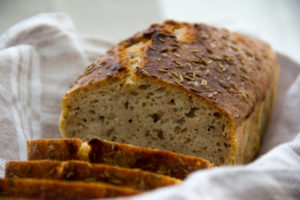
The oldest and most sacred item on a Lithuanian’s table remains bread. It can vary in color and taste; however, black rye bread is the most valued. Depending on the family traditions, it is eaten for breakfast, lunch and dinner. It would be hard to find a Lithuanian who would resist a smell of a freshly baked bread.
In Lithuanian folklore, bread is described in only the kindest words. It is a symbol of abundance and family welfare. It is also associated with old rites – if a slice falls to the ground, it is necessary to kiss and apologize to the bread when picking it up.
RECIPE:
1 Tbsp salt
5 Tbsp sugar
8 cups (1 kg) flour (wheat, wholegrain, spelt, rye or combo)
4 ⅓ cups (1 l) warm water
~ ¾ cup (150 g) sourdough starter
Caraway seeds
Any type of seeds, nuts or dried fruit, if desired
Mix salt, sugar and seeds, if using with flour in a large bowl. Add starter and slowly pour warm water while mixing. Finish kneading with hands to work the ingredients together, making sure that there are no dry bits of flour. Cover the bowl and let the dough ferment for 7-10 hours on your kitchen counter or in a 77-86°F (25-30°C) area of your home. The dough should have risen by 50% and show signs of fermentation, bubbles on top and sides of the dough. Place the dough into an oil sprayed baking pan. Sprinkle some caraway seeds on top of the loaf. Put in a cold oven and bake for 1h 10 min in a 395°F (200°C). Let the bread cool completely on a rack before slicing.
BULVINIAI BLYNAI (POTATO PANCAKES)
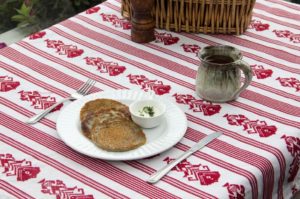
While we cannot claim that potato pancakes are a purely Lithuanian dish, they are nevertheless an inseparable part of our cuisine and tradition. It wasn’t until the late 18th century that potatoes were introduced in Lithuania, but now they dominate our cuisine. They’re especially craved in colder seasons. During one of the oldest celebrations – Uzgavenes (farewell of Winter), they get special attention. It’s believed if you don’t eat pancakes that day, winter might stay longer! Usually they are served with sour cream, some add dill, others like it with kefir or buttermilk.
RECIPE:
2 lbs idaho potatoes (~5-6 large), peeled
1 egg
1 onion, medium, peeled
1 Tbs flour or corn starch
salt, to taste
neutral oil, for cooking
With a box grater, grate potatoes and onions into a smooth puree. Add egg, flour, salt and mix well. Pan fry the pancakes in medium hot oil until golden on both sides. Tip: best to use old potatoes for this recipe. For salt – potatoes need quite a bit. Start with a tablespoon, add more if needed.
KASTINYS (WHIPPED SOUR CREAM DIP)
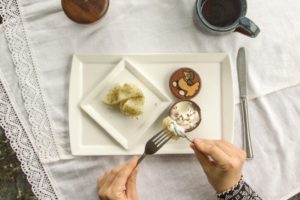
A traditional Samogitian (Western Lithuanian) dish made from sour cream, curdled milk, butter. Garlic, caraway and hemp seeds can be also added. Usually served with hot potatoes, kastinys is especially valued for its unique taste and has been added to the Lithuanian Culinary Heritage Fund – and organization that protects uniquely Lithuanian food items. The texture of kastinys is light, with a distinctly sour flavor.
RECIPE:
8oz full fat sour cream (1 tub), room temperature
2 Tbsp butter
1 large clove of garlic (or more), crushed or finely minced
0.5 tsp salt or to taste
1 tsp caraway seeds (optional)
Put a heavy bottomed bowl on top of a small pot of lightly simmering water (bain marie). Glass pyrex bowl works well and a thick clay bowl is ideal. Make sure the bowl doesn’t touch the water. Add butter, let it melt almost fully. Take the bowl off the heat and add 1 Tbsp sour cream. Mix until incorporated. Repeat until all the sour cream is incorporated and the mix is smooth and slightly thicker than sour cream itself. While working the emulsion, if the mix gets too stiff, keep it on top of the simmering water longer. If the mix is getting too runny – it’s too hot. Add more sour cream and mix well. When done, add the seasonings and mix well. Tip: if you ever made mayo, the idea of this process is similar.
ŠALTIBARŠČIAI (COLD BEET SOUP)

It is probably the most famous pink soup in the world getting its natural color from the beats. This soup is most wanted during the summers. It is refreshing, healthy and filling, especially if you eat it with hot potatoes.
It could be served as an appetizer or a main. It got so popular that you can find it in most Lithuanian restaurants from a small town to a big city.
RECIPE:
1 quart buttermilk
1 jar shredded pickled beets, drained or 1 large beet, boiled, peeled and grated
1 English cucumber, grated
3 hard boiled eggs, peeled and chopped
2 Tbsp chopped fresh dill
2 green onions, whole, chopped
salt, to taste
milk or water, as needed
Mix all ingredients in a bowl. Adjust the thickness with water or milk, if desired. Let sit for the flavors to meld. If you have trouble finding pickled beets, can substitute with a fresh beet, or easily pickle your own. Traditionally served with warm boiled potatoes and fresh dill.
MEDUTIS (HONEY CAKE)
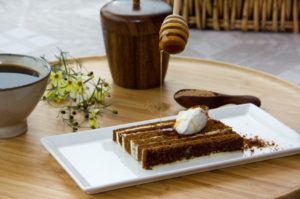
No matter the variations in recipes, this cake is deep-rooted in the Lithuanian cuisine. It is served on all occasions from weddings to birthdays, but you can simply have it with a cup of coffee or tea after lunch. It’s taste will brighten your day.
RECIPE:
Cake
0.5 cup butter
1 cup sugar
3 Tbsp honey
4 cups flour
2 eggs
1 tsp baking soda
1 tsp baking powder
Cream
4 cups sour cream
¼ cup powdered sugar
2 Tbsp lemon juice
1.5 Tbsp unflavored gelatin
For the cake: In a small pot add sugar, honey and butter. Hear gently until melted and incorporated, cool slightly. In a large bowl, beat the eggs by hand. Slowly add honey mix to eggs constantly stirring – careful not to scramble. Add flour, baking powder and baking soda to the bowl and knead the dough until it’s not sticky anymore. Divide the dough in 5 even pieces and roll each piece into a circle or rectangle. Cook each piece of dough on a parchment paper lined cookie sheet in a 400F degree oven for 3-4 minutes each, until it turns brown. Using a round plate, cut circles out of each sheet to a desired circumference. Alternatively, you can cut it into rectangles.
For the cream: bloom the gelatin in a bit of water. Heat it up gently in the microwave until melted. Mix sour cream, powdered sugar and lemon juice together. Add cooled gelatin. Chill the cream in the fridge until it’s set and ready to layer.
Assemble by layering cream with cake layers. Finish by smearing cream on the outside of the cake as well. If desired, crumble the left over cut off cake into crumbs and cover the cake with them.
SPURGOS (FARMER’S CHEESE DOUGHNUTS)
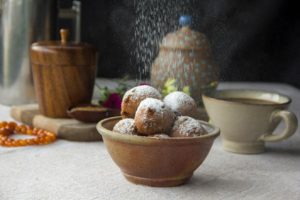
Freshly fried Spurgos are fluffy and soft inside. Less work than the yeast based doughnuts they’re a breeze to prepare. Expand your doughnut experience – once you have a bite, it will be hard to stop!
RECIPE:
10oz crumbly farmer’s cheese (dry cottage cheese)
4 Tbsp sugar
2 eggs
0.5 tsp vanilla extract
5 Tbsp flour
1 tsp baking powder
oil, for deep frying
powdered sugar, for dusting
Put farmer’s cheese and sugar in a bowl and smash it well with a fork until the mix is smooth. Add eggs and vanilla, mix well. Then add flour and baking powder and mix using a spoon. The dough should be thick and difficult to mix. If it’s easy to mix, add a bit more flour. Heat the oil in a pot on a medium heat (to ~325F). Grab a spoonful of dough and roll it a bit with wet palms to make it more round. Fry in small batches until the doughnuts are deep golden brown. Drain on a paper towel well. Dust with powdered sugar while still hot.

Pingback: Share your Lithuanian Cuisine gems! - Vakarų Vėjai